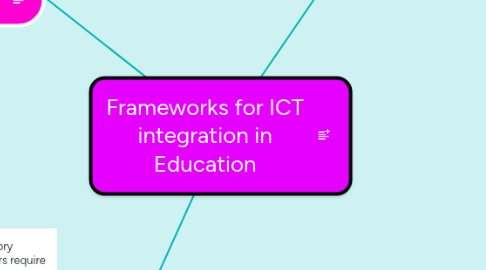
1. Connectivism
1.1. Connectivism is the integration of elements investigated by chaos, network, and complexity theories, as well as self-organization theories. Learning is a process that occurs in nebulous surroundings with altering basic elements that are not entirely within the control of the individual. Connectivism is motivated by the realization that decisions are made on rapidly shifting foundations. New information is constantly being gathered. It is critical to be able to distinguish between crucial and unimportant information. The capacity to recognize when new information changes the picture as a result of decisions taken yesterday is equally essential (WEST, 2018).
1.2. Advantages
1.2.1. Individual perspectives and differences of opinion are encouraged by the theory, which theoretically allows for no hierarchy in the value of common knowledge (WEEBLY, n.d.).
1.3. Disadvantages
1.3.1. It is questionable how educators who develop instruction based on this approach will meet the existing standardized testing system's content-specific requirements (WEEBLY, n.d.).
2. Technological Pedagogical Content Knowledge (TPACK)
2.1. Technological Pedagogy Content Knowledge (TPACK) is a theory established to explain the collection of knowledge that teachers require to teach their learners successfully and to use technology. It seeks to define the type of knowledge necessary by teachers for technology integration in their classrooms, while also addressing the complex, multifaceted, and situational aspect of teacher knowledge (Santos & Castro, 2021).
2.2. Advantages
2.2.1. TPACK is the building block of effective teaching with technology, requiring an understanding of the illustration of concepts using technologies; pedagogical techniques that use technologies in beneficial ways to teach content; and knowledge with what makes concepts difficult or easy to learn and how technology can help (Koehler & Mishra, 2016).
2.3. Disadvantages
2.3.1. Even though the TPACK model synthesizes three key components for successful technology integration in the classroom, the model has inherent limitations. Teachers' views of technology, school culture or regulations, and physical access to technology are three major elements that contribute to these hurdles (Adams, 2019).
3. Bloom’s Digital Taxonomy
3.1. The purpose of Bloom's Digital Taxonomy is to teach educators how to use technology and digital tools to improve learner experiences and outcomes. It strives to broaden the skills associated with each level as technology becomes a more ingrained and necessary aspect of learning. The focus of this framework and the examples of tools it gives should be on how the tools should operate as vehicles for shifting learner thinking at various levels, rather than on the tools themselves. Each level is accompanied by a description of its significance as well as examples of digital tools that are linked to this taxonomy framework (Sneed, 2016).
3.2. Advantages:
3.2.1. Bloom's taxonomy can assist us in identifying learning objectives that entail a higher level of cognitive function, allowing us to be better problem solvers. The advantage is that the user retains control. This is also known as the process by which a student creates a Personal Learning Environment (PLE) (Benitez, 2012).
3.3. Disadvantages:
3.3.1. It encourages us to organize classroom education in opposition to how we genuinely learn. If we agree that understanding is frequently formed through application and creation, we must provide opportunities for learners to create (and analyse) things most of the time. They will acquire knowledge and understanding as they create and analyse. They can start creating things straight away in a study. They may actively engage their minds and hands in the creating process, as well as analyse their understanding, both individually and collaboratively (Contributing Blogger, 2018).
